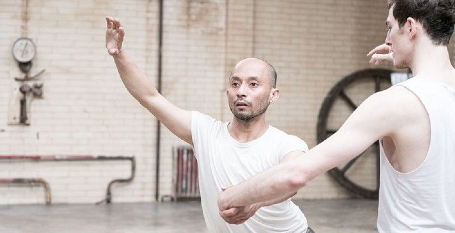Man to Monk is a four-year project, tracing the performative shift of dance artist Mavin Khoo.
Khoo’s intention with the pieces is to challenge Western and Eastern ideas about methods of choreographic creation through a ‘lived experience’ creative process.
As part of the development process of the series, Victor Callens joined Khoo for a duet choreographed by Carlos Pons Guerra.
We spoke with Khoo for a behind-the-scenes look at the work.
Why was Carlos Pons Guerra the right choreographer for this collaboration?
I’d heard of this young Spanish emerging choreographer and interestingly, quite a few artists had suggested that he may be a choreographer of interest to me. I started checking him out and was intrigued by his interest in cinematic theatricality from a queer perspective. Carlos has an almost Almodovar sensibility to his work which I find exciting, and also works with a formalist framework. All these qualities combined together really presented a sense of irony which I have a particular love for.
There was also another element that was hugely important to me. I really wanted to work with someone who would be open to really going somewhere with me through the process of the work - someone who would inevitably really know me in order to create, as opposed to just coming into the studio and working with me as what he found in the work space. Carlos was open to delving deep into this part of the work. We spent several phases cohabiting, which really forced an intimacy that drew out of each of us all kinds of emotional dynamics that would never have come about had we sustained a purely studio-based relationship.
What was the inspiration for this story of the encounter between a man and a god?
The starting point was actually personal. This work marks a significant shift in my artistic and personal journey, where my direction is focused on the transcendental experience. It has to do very much with age, as well as the specificity of the cultural lineage that I come from.
As an Indian dancer, our main thematic framework – in repertoire – is always the journey of spiritualism that arises through the physical love between God and self. I’ve lived my whole life working with this philosophy, and for me as a dancer I’ve come to a point where my goal in each performance is to ensure that the audience comes to a point of transcendence.
When I conceived the idea of a four-year project that would entail two full-length duet works in two phases, I was keen to determine one duet as Man - which is this is the work with Carlos and Victor - and the other as Monk, with another choreographer and dancer.
Man is essentially the physical part of the journey, which I felt Carlos was perfect for. All those experiences of life that deal with lust, sex, love, and all the emotions that come with these, act as the precursor to the next piece, Monk. It suggests that in order for all those elements of spiritualism and God to be understood, we first and foremost have to understand what it is to be Man.
You’re dancing this piece with Victor Callens – what was the casting process?
I’ve never danced with Victor before. I was actually very worried about who I’d invite to dance with me. I’m a complex person to work with - for me, process is everything, and I knew that I wanted to push this particular process and needed to find a partner that would really come on the journey with me with no inhibitions and resistance. It really wasn’t about technical ability - I know a lot of good, strong dancers - it was really about temperament and artistry.
Victor was recommended by one of my coaches, Nico Monaco, who had worked with him in Emio Greco’s company. With Victor, I’m lucky to have a beautiful dancer who has a sensitive and secure temperament. We’re both searching for the same thing, which is crucial in a partnership.
Bharatanatyam is generally a solo style of dance - does this piece represent the Bharatanatyam style or is it something else?
This is complex. The piece is essentially framed by a philosophical framework that belongs to Bharatanatyam - the ideas of love and God. It also carries a strong resonance of the traditional narrative compositions used in Bharatanatyam, which is the idea of Love in Separation.
Carlos and I were quite clear that what we didn’t want to do was simplify what is essentially complex by including some Bharatanatyam steps into the work to demonstrate a kind of hybrid dance language. It’s really much deeper than that - the Bharatanatyam element is very much there as an embodied state or presence within me. I feel strongly about this.
There’s already too much appropriation that happens generally, which only provides some kind of ‘easy’ access. I want the incorporation of the Bharatanatyam roots in the work to be felt and not really seen.
Where does this piece sit in the journey of your Man to Monk project?
This piece is Man, it’s the part that explores all those idea that come with love, sex and desire. I guess that there’s also a specificity in its queer nature that comes out of Carlos, Victor, and myself. However, I feel strongly that the emotive elements are not limited to just the queer experience. In the end, it’s relatable to everyone.

